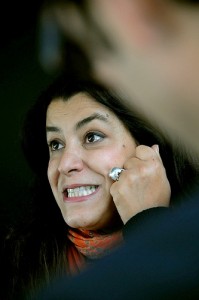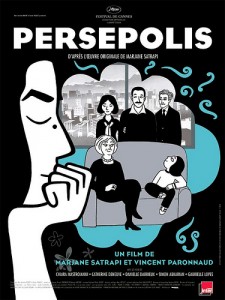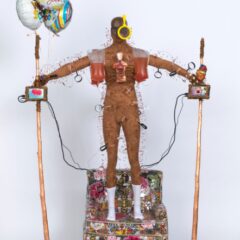Wednesday was a long night if you were one of the eight hundred people who waited to hear Marjane Satrapi speak about the Complete Persepolis (Pantheon, $24.95), chosen for this year’s One Book, One Philadelphia. The night was also emotional. Mayor Nutter confessed that passing bill 1828 was “the most emotionally challenging” situation he ever undertook in his 25-year political career. Applause was loud and long for the library staff who prepared for Satrapi’s talk, even though a week ago they did not know whether or not they’d still have a job come Oct 2nd. As Marjane Satrapi walked onstage, the crowd rose to a standing ovation. The whites of her eyes widened and for a moment we saw her transform into her cartoon self-portrait. I don’t know if we were either clapping for her, or showing our gratitude that the Doomsday plan never happened.
Marjane Satrapi (MAHR-john sah-TROP-ee) is an amazing and effortless speaker. Through jokes, self-deprecation, and candidness she turned the art nouveau lectern at the front of Montgomery Auditorium into a kitchen table with the audience sitting around her. She insisted on referring to herself as a “cartoonist” and her books as “comic books,” not “graphic novels.” Satrapi believes that the term graphic novel was devised to compensate for the shame many adults feel about reading comic books. As she puts it, we have grown to equate comics with immaturity and in our minds, “only children and retarded adults read them.” Satrapi explained that all children draw, and at a certain point in their development (around adolescence) they stop and focus on writing and reading. Adults do not draw. They drop the drawings along with the dolls.
Satrapi gave great insight onto the creative process, likening it to the growth of a baby inside the womb, “It doesn’t just all of a sudden grow a leg, then pop out an eyeball, it all comes gradually at the same time.” The words and the drawings emerge simultaneously. It is always refreshing to hear this from a creative person’s own mouth. At times with those whom we admire, her/his success and brilliance can make the work seem unattainable, but Satrapi is very practical about the literal and emotional work that went into Persepolis.
She also explained her early influences. She was familiar with comics as a child in Iran, which as a Shiite country allowed human representation and also has the history of Persian miniatures. Satrapi shared a story of going bowling (“we made some bowling”) in Tehran in 1977 at the age of eight with her cousin, eating burgers at Big Boy, and then going to an American comic book store where she got copies of Dracula. Through the book she learned that the way to become a vampire was through raw chicken consumption (she pronounced raw like “ruh” and as she went on animatedly with this anecdote, parts of the audience shuffled and murmured “what did she say?” desperately trying to not miss a joke). She and her cousin ate raw chicken throughout that summer and had worms in a matter of months. She mentioned that she didn’t become a “comic reader” until she arrived in France in 1994, where she read Maus by Art Spiegelman. The audience “ooh”-ed collectively.

During the Q&A session someone asked for her opinion on the French government banning headscarves in schools in 2004. She asserted that she was strongly against the ban. Even though she hated wearing the veil as a young woman in Iran, she acknowledged that these young women saw the veil as something that connected them to their culture. These girls were neither quite French nor Arabs, and though their mothers didn’t wear the veil, they wanted to as a sign of their own second-generation rebellion. Satrapi told a story about going to an Iranian club in Paris (called “Jet Set”). A veiled woman sat watching the crowd from a table, making Satrapi grow increasingly uncomfortable and embarrassed. This woman seemed to be a symbol of piety and sternness in the middle of this half-naked dancing crowd. A group of “Arabic dancers” came onto the floor, perhaps a notch or two above strippers, and Satrapi saw the veiled woman beckon one of the women closer with a crooked finger. “I thought the dancer was really going to get it, receive a moral lesson.” To Satrapi’s jaw-dropping surprise, the woman stuck a 100-franc note in the dancer’s bra top and said, “you dance so well, please dance for me.” It became clear that it was this woman’s choice to be veiled. She wasn’t judging anyone, it was simply a part of her identity, much like the girls who wanted to wear the veil at school.
Satrapi spoke openly about writing an autobiography (even though she doesn’t’ categorize Persepolis as one). She depended on her memory and her honesty in retelling stories, which included admitting things that she was not proud of, like turning someone over to the Guardians of the Revolution in Iran to “save her own skin” and not get arrested and possibly raped/executed (they weren’t allowed to kill virgins). She acknowledged part of the creative process was mistake-making, self-criticism, and in turn, criticism of others. In the Q&A session a local teacher asked if she had anything to say to the students in the Philadelphia schools who would be reading her book. Although Marjane Satrapi slightly faltered when put on the spot and didn’t quite answer the question in that moment, her candidness and sincerity of character through out the whole talk is absolutely something worth noting and discussing. Keep an eye out for the podcast coming soon on the Free Library One Book website.










